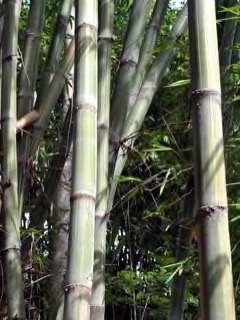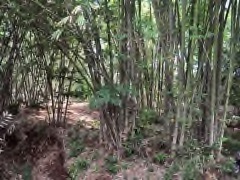 |
|
wikimedia.org Wibowo Djatmiko (Wie146) |
 |
| wikimedia.org Wibowo Djatmiko (Wie146) |
Translate this page:
Summary
Physical Characteristics

 Gigantochloa verticillata is an evergreen Bamboo growing to 15 m (49ft) by 6 m (19ft) at a fast rate.
Gigantochloa verticillata is an evergreen Bamboo growing to 15 m (49ft) by 6 m (19ft) at a fast rate.
See above for USDA hardiness. It is hardy to UK zone 10. The flowers are pollinated by Wind.
Suitable for: light (sandy) and medium (loamy) soils and prefers well-drained soil. Suitable pH: mildly acid, neutral and basic (mildly alkaline) soils. It cannot grow in the shade. It prefers moist soil.
UK Hardiness Map
US Hardiness Map
Synonyms
Arundo maxima Oken Bambos verticillata Poir. Bambusa excelsa (Roep. ex Trin.) Miq. Bambusa pseudoarundinacea Steud. Bambusa verticillata Willd. Gigantochloa pseudoarundinacea (Steud.) Widjaja Melocanna excelsa Roep. ex Trin. Nastus verticillatus (Willd.) Sm.
Plant Habitats
Edible Uses
Edible Parts: Shoots
Edible Uses:
The young shoots are eaten as a vegetable, especially those of less robust forms[310 ].
References More on Edible Uses
Medicinal Uses
Plants For A Future can not take any responsibility for any adverse effects from the use of plants. Always seek advice from a professional before using a plant medicinally.
None known
References More on Medicinal Uses
The Bookshop: Edible Plant Books
Our Latest books on Perennial Plants For Food Forests and Permaculture Gardens in paperback or digital formats.

Edible Tropical Plants
Food Forest Plants for Hotter Conditions: 250+ Plants For Tropical Food Forests & Permaculture Gardens.
More

Edible Temperate Plants
Plants for Your Food Forest: 500 Plants for Temperate Food Forests & Permaculture Gardens.
More

More Books
PFAF have eight books available in paperback and digital formats. Browse the shop for more information.
Shop Now
Other Uses
Basketry Biomass Charcoal Fodder Furniture Pipes Teeth Wood
The canes are used for building material, water pipes, furniture, household utensils, chopsticks and toothpicks. They are also used to make basketry (although Gigantochloa apus is preferred), and musical instruments (although Gigantochloa atroviolacea is preferred)[310 ]. The culm can range in length from 7 - 30 metres, they are 5 - 13 cm in diameter at the base, with internodes 40 - 60cm long and a thick wall up to 2 cm wide[310 ]. The canes are green to yellow-green, yellow striped, initially with scattered appressed brown hairs on the upper parts, glabrous and smooth when older[310 ]. The culms might be used to make charcoal[310 ]. The energy value for charcoal made from the culms is about 30 000 kJ/kg[310 ].
Special Uses
Carbon Farming Food Forest
References More on Other Uses
Cultivation details
Fodder: Bank Industrial Crop: Biomass Management: Managed Multistem Regional Crop
A plant of the perhumid tropics growing at elevations from sea-level up to about 1,200 metres[310 ]. It is found in areas with an annual rainfall in the range of 2,350 - 4,200 mm, an average temperature of 20 - 32°c and average relative humidity of over 70%[310 ]. In Indonesia (West Java), the culms grown on hill slopes ( at elevations of 500 metres with an annual rainfall of around 4,200 mm) are stronger (higher specific gravity, bending and tensile strength) than culms grown in valleys[310 ]. Grows best on sandy loams and alluvial soils[310 ]. One year after planting of a cutting, 7 - 10 culms have emerged[310 ]. Per year, about 8 - 9 culms per clump reach full size[310 ]. Bamboos have an interesting method of growth. Each plant produces a number of new stems annually - these stems grow to their maximum height in their first year of growth, subsequent growth in the stem being limited to the production of new side branches and leaves. In the case of some mature tropical species the new stem could be as much as 30 metres tall, with daily increases in height of 30cm or more during their peak growth time. This makes them some of the fastest-growing species in the world[K ]. A young culm grows fast, attaining full height in 3 - 4 months with an average growing rate of 3.4 cm per day[310 ]. Bamboos in general are usually monocarpic, living for many years before flowering, then flowering and seeding profusely for a period of 1 - 3 years before usually dying. Flowering occurs when the clump is 50 - 60 years old; it flowers gregariously, after which the clump dies[310 ]. First harvesting may start 3 years after planting, preferably in the dry season[310 ]. It is recommended to harvest only 3-year-old culms and to cut just above the ground[310 ]. To promote regeneration, it is recommended to earth up and to mulch the base of the harvested culms[310 ]. The annual yield of mature culms from a plantation with 275 clumps per ha (6 m x 6 m) is estimated at 1,650 per ha or about 6 culms per clump[310 ]. If converted to charcoal, about 18% good charcoal and 4% brand and broken charcoal are produced310]. Traditionally, the culms are left leaning upright against a tree for some days before being used. Sometimes culms are first soaked in running water or mud for some time[310 ]. Experiments with preservation by soaking in a chemical solution of e.g. Caustic soda or boric acid show promising results[310 ].
Carbon Farming
-
Fodder: Bank
Fodder banks are plantings of high-quality fodder species. Their goal is to maintain healthy productive animals. They can be utilized all year, but are designed to bridge the forage scarcity of annual dry seasons. Fodder bank plants are usually trees or shrubs, and often legumes. The relatively deep roots of these woody perennials allow them to reach soil nutrients and moisture not available to grasses and herbaceous plants.
-
Industrial Crop: Biomass
Three broad categories: bamboos, resprouting woody plants, and giant grasses. uses include: protein, materials (paper, building materials, fibers, biochar etc.), chemicals (biobased chemicals), energy - biofuels
-
Management: Managed Multistem
Regularly removing some multiple stems. A non-A non-destructive management systems maintaining the soil organic carbon.
-
Regional Crop
These crops have been domesticated and cultivated regionally but have not been adopted elsewhere and are typically not traded globally, Examples in this broad category include perennial cottons and many nuts and staple fruits.
References Carbon Farming Information and Carbon Sequestration Information
Temperature Converter
Type a value in the Celsius field to convert the value to Fahrenheit:
Fahrenheit:
The PFAF Bookshop
Plants For A Future have a number of books available in paperback and digital form. Book titles include Edible Plants, Edible Perennials, Edible Trees,Edible Shrubs, Woodland Gardening, and Temperate Food Forest Plants. Our new book is Food Forest Plants For Hotter Conditions (Tropical and Sub-Tropical).
Shop Now
Plant Propagation
Gigantochloa pseudoarundinacea is only propagated vegetatively by rhizome, culm or branch cuttings. Cuttings from flowering clumps should be avoided because they will start flowering soon after planting. Culm cuttings have shown a survival rate of nearly 100%. In Indonesia, the best time for planting is in the rainy season from December to March. Recommended spacing is 8 m x 8 m, and high rainfall areas are preferred[310 ].
Other Names
If available other names are mentioned here
Awi andong, Awi gombong, Awi temen, Bamboo andong, Bamboo ater, Bambu belang raksasa, Buluh Jawa, Clumping bamboo, Kayali, Pereng keles, Pring legi, Pring surat, Wa-pyu
Native Range
TROPICAL ASIA: Borneo, Cambodia, Jawa, Malaya, Myanmar, Sumatera, Thailand, Vietnam,
Weed Potential
Right plant wrong place. We are currently updating this section.
Please note that a plant may be invasive in one area but may not in your area so it's worth checking.
None Known
Conservation Status
IUCN Red List of Threatened Plants Status : This taxon has not yet been assessed

Growth: S = slow M = medium F = fast. Soil: L = light (sandy) M = medium H = heavy (clay). pH: A = acid N = neutral B = basic (alkaline). Shade: F = full shade S = semi-shade N = no shade. Moisture: D = dry M = Moist We = wet Wa = water.
Now available:
Food Forest Plants for Mediterranean Conditions
350+ Perennial Plants For Mediterranean and Drier Food Forests and Permaculture Gardens.
[Paperback and eBook]
This is the third in Plants For A Future's series of plant guides for food forests tailored to
specific climate zones. Following volumes on temperate and tropical ecosystems, this book focuses
on species suited to Mediterranean conditions—regions with hot, dry summers and cool, wet winters,
often facing the added challenge of climate change.
Read More
Expert comment
Author
(Willd.) Munro
Botanical References
Links / References
For a list of references used on this page please go here
A special thanks to Ken Fern for some of the information used on this page.
Readers comment
| Add a comment |
|
If you have important information about this plant that may help other users please add a comment or link below. Only comments or links that are felt to be directly relevant to a plant will be included. If you think a comment/link or information contained on this page is inaccurate or misleading we would welcome your feedback at [email protected]. If you have questions about a plant please use the Forum on this website as we do not have the resources to answer questions ourselves.
* Please note: the comments by website users are not necessarily those held by PFAF and may give misleading or inaccurate information.
To leave a comment please Register or login here All comments need to be approved so will not appear immediately.
|
Subject : Gigantochloa verticillata
|
|
|
|